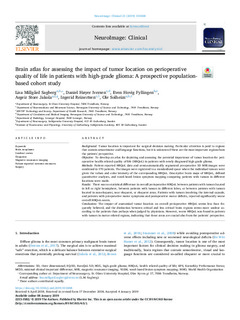| dc.contributor.author | Sagberg, Lisa Millgård | |
| dc.contributor.author | Iversen, Daniel Høyer | |
| dc.contributor.author | Fyllingen, Even Hovig | |
| dc.contributor.author | Jakola, Asgeir Store | |
| dc.contributor.author | Reinertsen, Ingerid | |
| dc.contributor.author | Solheim, Ole | |
| dc.date.accessioned | 2019-05-24T06:10:40Z | |
| dc.date.available | 2019-05-24T06:10:40Z | |
| dc.date.created | 2019-01-08T23:06:43Z | |
| dc.date.issued | 2019 | |
| dc.identifier.citation | NeuroImage: Clinical. 2019, 21 1-11. | nb_NO |
| dc.identifier.issn | 2213-1582 | |
| dc.identifier.uri | http://hdl.handle.net/11250/2598620 | |
| dc.description.abstract | Background Tumor location is important for surgical decision making. Particular attention is paid to regions that contain sensorimotor and language functions, but it is unknown if these are the most important regions from the patients' perspective. Objective To develop an atlas for depicting and assessing the potential importance of tumor location for perioperative health-related quality of life (HRQoL) in patients with newly diagnosed high-grade glioma. Methods Patient-reported HRQoL data and semi-automatically segmented preoperative 3D MRI-images were combined in 170 patients. The images were registered to a standardized space where the individual tumors were given the values and color intensity of the corresponding HRQoL. Descriptive brain maps of HRQoL, defined quantitative analyses, and voxel-based lesion symptom mapping comparing patients with tumors in different locations were made. Results There was no statistical difference in overall perioperative HRQoL between patients with tumors located in left or right hemisphere, between patients with tumors in different lobes, or between patients with tumors located in non-eloquent, near eloquent, or eloquent areas. Patients with tumors involving the internal capsule, and patients with preoperative motor symptoms and postoperative motor deficits, reported significantly worse overall HRQoL-scores. Conclusions The impact of anatomical tumor location on overall perioperative HRQoL seems less than frequently believed, and the distinction between critical and less critical brain regions seems more unclear according to the patients than perhaps when judged by physicians. However, worse HRQoL was found in patients with tumors in motor-related regions, indicating that these areas are crucial also from the patients' perspective. | nb_NO |
| dc.language.iso | eng | nb_NO |
| dc.publisher | Elsevier | nb_NO |
| dc.rights | Attribution-NonCommercial-NoDerivatives 4.0 Internasjonal | * |
| dc.rights.uri | http://creativecommons.org/licenses/by-nc-nd/4.0/deed.no | * |
| dc.title | Brain atlas for assessing the impact of tumor location on perioperative quality of life in patients with high-grade glioma: A prospective population-based cohort study | nb_NO |
| dc.type | Journal article | nb_NO |
| dc.type | Peer reviewed | nb_NO |
| dc.description.version | publishedVersion | nb_NO |
| dc.source.pagenumber | 1-11 | nb_NO |
| dc.source.volume | 21 | nb_NO |
| dc.source.journal | NeuroImage: Clinical | nb_NO |
| dc.identifier.doi | 10.1016/j.nicl.2019.101658 | |
| dc.identifier.cristin | 1652839 | |
| dc.description.localcode | © 2019 The Authors. Published by Elsevier Inc. Open Access CC BY-NC-ND 4.0 | nb_NO |
| cristin.unitcode | 194,65,30,0 | |
| cristin.unitcode | 194,65,25,0 | |
| cristin.unitname | Institutt for nevromedisin og bevegelsesvitenskap | |
| cristin.unitname | Institutt for sirkulasjon og bildediagnostikk | |
| cristin.ispublished | true | |
| cristin.fulltext | original | |
| cristin.qualitycode | 1 | |

